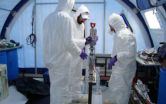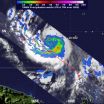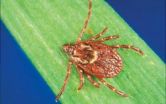(Press-News.org) Researchers funded by the National Science Foundation (NSF) describe in a new publication a viable community of bacteria that ekes out a living in a dark, salty and subfreezing environment beneath nearly 20 meters of ice in one of Antarctica's most isolated lakes.
The finding could have implications for the discovery of life in other extreme environments, including elsewhere in the solar system.
If, as the researchers postulate, the bacteria survive purely from chemical reactions, as opposed to drawing energy from the sun or other sources, "this gives us an entirely new framework for thinking of how life can be supported in cryo-ecosystems on Earth and in other icy worlds of the universe," said Alison Murray of Nevada's Desert Research Institute (DRI), the lead author on the paper.
The findings were published this week in the Proceedings of the National Academy of Science.
Murray and Christian Fritsen, also at DRI, co-authored the paper along with Peter Doran and Fabien Kenig at the University of Illinois at Chicago.
The team's work was supported by NSF, which manages the United States Antarctic Program (USAP). Through the USAP, NSF coordinates all U.S. research on the southernmost continent and in the Southern Ocean
Lake Vida is the largest of several unique lakes found in the McMurdo Dry Valleys, an ice-free area of the continent.
Lake Vida contains no oxygen, is mostly frozen and possesses the highest nitrous-oxide levels of any natural body of water on Earth. A briny liquid that is approximately six times saltier than seawater percolates throughout the icy environment below a depth of 16 meters with an average temperature of minus 13.4 degrees Celsius (or 8 degrees Fahrenheit).
"This study provides a window into one of the most unusual ecosystems on Earth," said Murray. "Our knowledge of geochemical and microbial processes in lightless icy environments, especially at subzero temperatures, has been very limited up until now. This work expands our understanding of the types of life that can survive in these isolated, cryo-ecosystems and how different strategies may be used to exist in such challenging environments."
Murray is a molecular microbial ecologist. She has been a polar researcher for the past 17 years and has participated in 14 expeditions to the Southern Ocean and Antarctic continent.
Despite the very cold, dark and isolated nature of the habitat, the researchers report that the brine harbors a surprisingly diverse and abundant assemblage of bacteria that survive, unlike most life on the planet, without drawing energy, either directly or indirectly, from the sun. Previous studies of Lake Vida dating back to 1996 indicate that the brine has been isolated from outside influences for more than 3,000 years.
Murray and her co-authors and collaborators--including the project's principal investigator, Peter Doran, of the University of Illinois at Chicago--developed stringent protocols and specialized equipment for their 2005 and 2010 field campaigns that allowed them to sample the lake's brine while avoiding contaminating the pristine ecosystem.
To sample the unique environment, researchers worked in a secure, sterile tent on the lake's surface to keep the site and equipment clean as they drilled ice cores, collected samples of the salty brine residing in the lake ice. With these samples they assessed the chemical qualities of the water and its potential for harboring and sustaining life, and described the diversity of the organisms detected.
Geochemical analyses suggest that chemical reactions between the brine and the underlying iron-rich sediments generate nitrous oxide and molecular hydrogen. The latter, in part, may provide the energy needed to support the brine's diverse microbial life.
"It's plausible that a life-supporting energy source exists solely from the chemical reaction between anoxic salt water and the rock," explained Fritsen, a systems microbial ecologist and research professor in DRI's Division of Earth and Ecosystem Sciences.
Murray added that further research is currently underway to analyze the abiotic, chemical interactions between the Lake Vida brine and the sediment, in addition to investigating the microbial community by using genomic sequencing approaches. The results could help explain the potential for life in other salty, cryogenic environments beyond Earth.
The Lake Vida brine also represents a cryo-ecosystem that is a suitable and accessible analog for the soils, sediments, wetlands, and lakes underlying the Antarctic ice sheet that other polar researchers are just now beginning to explore.
INFORMATION:
Ancient microbes survive beneath the icy surface of Antarctic lake
Findings related to microbe metabolism could have significance for the search for life in other worlds
2012-12-01
ELSE PRESS RELEASES FROM THIS DATE:
Vitamin D tied to women's cognitive performance
2012-12-01
Two new studies appearing in the Journals of Gerontology Series A: Biological Sciences and Medical Sciences show that vitamin D may be a vital component for the cognitive health of women as they age.
Higher vitamin D dietary intake is associated with a lower risk of developing Alzheimer's disease, according to research conducted by a team led by Cedric Annweiler, MD, PhD, at the Angers University Hospital in France.
Similarly, investigators led by Yelena Slinin, MD, MS, at the VA Medical Center in Minneapolis found that low vitamin D levels among older women are associated ...
Geoscientists cite 'critical need' for basic research to unleash promising energy resources
2012-12-01
Developers of renewable energy and shale gas must overcome fundamental geological and environmental challenges if these promising energy sources are to reach their full potential, according to a trio of leading geoscientists. Their findings will be presented on Dec. 4, at 5:15 p.m. (PT), at the fall meeting of the American Geophysical Union (AGU) in San Francisco in Room 102 of Moscone Center West .
"There is a critical need for scientists to address basic questions that have hindered the development of emerging energy resources, including geothermal, wind, solar and ...
NASA sees 'hot towers' in intensifying Typhoon Bopha
2012-12-01
Bopha intensified into a typhoon today, Nov. 30, as it continues to affect the islands in Micronesia in the western North Pacific Ocean. NASA's TRMM satellite captured rainfall data of Bopha and noticed "Hot Tower" thunderstorms as it was intensifying from a tropical storm into a typhoon.
When NASA and the Japanese Space Agency's Tropical Rainfall Measuring Mission (TRMM) satellite passed over Bopha twice on Nov. 29, and the later data showed that the area of heaviest rainfall had expanded and was still south of the center of circulation. The heaviest rainfall was occurring ...
Emerging vector-borne diseases create new public health challenge
2012-12-01
Human activities are advancing the spread of vector-borne, zoonotic diseases such as West Nile virus, Lyme disease and dengue fever, report scientists publishing a series of papers today in the journal The Lancet.
Vector-borne zoonotic diseases result from disease-causing agents or pathogens that naturally infect wildlife, and are transmitted to humans by carriers such as mosquitoes and ticks. In short, they're diseases transmitted between animals and humans.
Widespread land-use change, globalization of trade and travel, and social upheaval are driving the emergence ...
ORNL develops lignin-based thermoplastic conversion process
2012-12-01
Turning lignin, a plant's structural "glue" and a byproduct of the paper and pulp industry, into something considerably more valuable is driving a research effort headed by Amit Naskar of Oak Ridge National Laboratory.
In a cover article published in Green Chemistry, the research team describes a process that ultimately transforms the lignin byproduct into a thermoplastic – a polymer that becomes pliable above a specific temperature. Researchers accomplished this by reconstructing larger lignin molecules either through a chemical reaction with formaldehyde or by washing ...
Preventing 'Cyber Pearl Harbor'
2012-12-01
Cyber attacks that have long caused major work disruption and theft of private information are becoming more sophisticated with prolonged attacks perpetrated by organized groups. In September 2012, Bank of America, Citibank, the New York Stock Exchange, and other financial institutions were targets of attacks for more than five weeks. Defense Secretary Leon E. Panetta warned that the United States was facing the possibility of a "cyber-Pearl Harbor" and was increasingly vulnerable to foreign computer hackers who could disrupt the government, utility, transportation, and ...
NASA's TRMM satellite video reveals 2012 hurricane season rainfall
2012-12-01
The 2012 Atlantic Hurricane season was a busy one as there were 19 tropical cyclones. A new NASA animation using data from the Tropical Rainfall Measuring Mission satellite known as TRMM shows rainfall from tropical cyclones in the western Atlantic, as measured from space.
The TRMM satellite has now been making highly accurate measurements of rainfall from space for fifteen years since it launched in Nov. 1997. TRMM is a joint mission between NASA and the Japanese space agency, JAXA.
TRMM can be used to calibrate rainfall estimates from other satellites. Those rainfall ...
In schizophrenia patients, auditory cues sound bigger problems
2012-12-01
Researchers at the University of California, San Diego School of Medicine and the VA San Diego Healthcare System have found that deficiencies in the neural processing of simple auditory tones can evolve into a cascade of dysfunctional information processing across wide swaths of the brain in patients with schizophrenia.
The findings are published in the current online edition of the journal Neuroimage.
Schizophrenia is a mental disorder characterized by disturbed thought processes and difficulty in discerning real from unreal perceptions. Common symptoms include auditory ...
Steroid injection linked with significant bone loss in postmenopausal women treated for back pain
2012-12-01
DETROIT – Postmenopausal women suffered significant bone density loss in their hip after they were treated with an epidural steroid injection for back pain relief, according to a Henry Ford Hospital study
Bone density loss after six months was six times greater when compared to the typical bone density loss seen in a year in a postmenopausal woman who doesn't receive steroid injection, researchers say.
Shlomo Mandel, M.D., a Henry Ford orthopedic physician and the study's lead author, says physicians should exercise caution prescribing an epidural steroid for select ...
Lung cancer patients with pockets of resistance prolong disease control by 'weeding the garden'
2012-12-01
The central skill of cancer is its ability to mutate – that's how it became cancerous in the first place. Once it's started down that path, it's not so difficult for a cancer cell to mutate again and again. This means that different tumors within a single patient or even different areas within the same cancerous deposit may develop different genetic characteristics. This heterogeneity helps cancer escape control by new, targeted cancer therapy drugs.
Two of these targeted drugs are crizotinib and erlotinib – they do wonders for the patients whose cancers depend on the ...
LAST 30 PRESS RELEASES:
Sandia’s economic impact sets record for 17th consecutive year
Researchers uncover how tumors become resistant to promising p53-targeted therapy
Aligning games and sets in determining tennis matches
UOC research team develops method to evaluate apps for treating depression
Extreme heat waves disrupt honey bee thermoregulation and threaten colony survival
New brain study explains how binge drinking contributes to long-lasting negative feelings
The Food and Drug Administration’s regulation of mifepristone
Prescribing patterns of potentially inappropriate central nervous system-active medications in older adults
One in four older Americans with dementia prescribed risky brain-altering drugs despite safety warnings
Social media use and well-being across adolescent development
Child poverty trends by race and ethnicity in the U.S. from 2022 to 2025
Tissue repair slows in old age. These proteins speed it back up
Korea University Institute for Environmental Health completed an invited training to strengthen environmental health capacity for Karakalpakstan Medical Institute
Study offers evidence that racial bias is at play in overrepresentation of Black youth in Canadian child welfare systems
JMIR Publications’ JMIR Neurotechnology invites submissions on novel technological advances for neurological disorders
JACC issues inaugural report on state of US cardiovascular health
SwRI evaluates fire risks associated with solar panel installations
Discovery on how aggressive breast cancer controls protein production
A simple blood test can predict Crohn’s disease years before symptoms appear
FAU study reveals social, family and health factors behind teen bullying
New alliance trial seeks to reduce delays in gastrointestinal cancer treatment
Discovery of a new superfluid phase in non-Hermitian quantum systems
Codes in the cilia: New study maps how Cilk1 and Hedgehog levels sculpt tooth architecture
Chonnam National University researchers develop novel virtual sensor grid method for low-cost, yet robust, infrastructure monitoring
Expanded school-based program linked to lower youth tobacco use rates in California
TV depictions of Hands-Only CPR are often misleading
What TV gets wrong about CPR—and why it matters for saving lives
New study: How weight loss benefits the health of your fat tissue
Astronomers surprised by mysterious shock wave around dead star
‘Death by a thousand cuts’: Young galaxy ran out of fuel as black hole choked off supplies
[Press-News.org] Ancient microbes survive beneath the icy surface of Antarctic lakeFindings related to microbe metabolism could have significance for the search for life in other worlds




